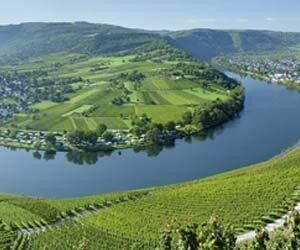
Origin: Mosel, Germany
Grape: Riesling
Body: Medium
Year: 2016
Alcohol: 8.5%
Price point: $22
Year Reviewed: 2018
So this was fun….I was going to teach two people who love sweet dessert wines (which they drink for any reason) how to rate and evaluate a wine. Here is what they came up with……with some very intense direction and coaching. “On the eyes, this is a clear pale lemon colored wine. They struggled with the smells they were getting on the nose, but after not letting them drink the wine, they finally came up with aromas of green fruit (green apple and pear), pineapple, nectar, and yeast. After their palates were refreshed twice, they experienced some pineapple, pear, nectarine and melon. They rated the wine as sweet, higher in acidity, medium body and a long finish, lasting over 2 minutes. They both rated the wine’s quality as Outstanding.” I truly enjoyed teaching them how to blog on this sweet balanced German wine, while I continued to drink my dry red one. Lol
The producer of this wine is Weingut Monchhof.

moenchhof.eymael@t-online.de
www.moenchhof.de
Robert Eymael leads since 1994 the Wine Estate. Joke and humor paired with a quality-conscious individualism, describe his philosophy, which reflects itself in the inimitable style of its Riesling wines. The Mönchhof, formerly in the possession of the Cisterian abbey Himmerod, is one of the oldest Wine ‘Estates at the Mosel. Pope Alexander III already confirmed the first Wine Estate possession of the abbey in the year 1177 in Uerzig. The monks of Himmerod built the wine-cellar at that time and in 1509 the estate you can admire today. In 1804, after the secularization by Napoleon, our family could acquire the Wine Estate in Paris.
Read more: http://www.snooth.com/winery/weingut-monchhof-urzig-mosel/#ixzz5Gwt9tHyp

The Mosel regions and steep banks
The Romans planted the first vineyards along the Mosel river and the city of Trier around the second century. Today, this region is known for its steep slopes overlooking the rivers, on which the vineyards are planted. Indeed, the steepest vineyard site in the world is located in the town of Bremm, with an incline of 65 degrees.
The Mosel and its vineyards
The Mosel has a very cool, northern continental climate, and such slopes are very effective in optimizing the vines’ exposure to sun, facilitating the ripening of the grapes. The best sites also take advantage of the solar radiation reflecting off the rivers’ surface and onto the vines, and the dark slate soil’s ability to absorb heat during the day and radiate it back to the vines at night. In summer the weather is warm, but certainly not hot, with an average July temperature of around 65ºF (18ºC). A long growing season helps develop the intense flavors in the Riesling grapes while keeping potential alcohol levels low.
One disadvantage of such steep vineyard sites is that they are inaccessible to machinery, meaning as much as seven times the amount of manual labor is required to tend them, compared to level vineyards. In winter, rain washes slate from high on the hillsides down to the rivers, and vineyard workers must gather it and carry it back up to the vineyards, where its heat-retaining properties are required. Occupational safety is a major issue on the very steep sites, and fatalities among vineyard workers have been known.
https://www.wine-searcher.com/regions-mosel
